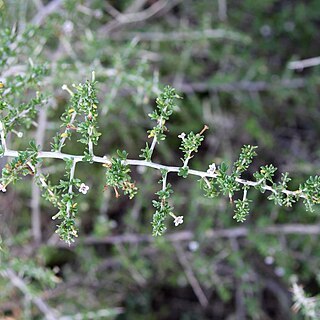Stiffly branched, thorny shrub to 2 m. Leaves in tufts on short shoots, leathery, obovoid, 7-17 x 1-2 mm. Flowers bisexual, tubular, white and purple, tube 5-7 mm long with petals 2.0-3.5 mmm long, stamens inserted ± halfway up tube, well exserted; calyx < half as long as corolla tube. Berries 3-5 mm diam., red.
Shrub, up to 2 m high, densely thorny, bark purplish brown. Leaves densely fascicled, narrowly oblong to spathulate, 7-17 mm, succulent, glabrous. Flowers bisexual; calyx 2.5-3.0 mm long; corolla 5-7 mm long; nectary brownish yellow, inconspicuous. Flowering time Aug.-Apr. Fruit ovoid or globose, red berry.
A small shrub. It keeps growing from year to year. It grows up to 2 m high. The stems are spiny and the leaves are succulent. The leaves are narrow and in clusters. The flowers are white or blue. They are tube shaped and 5-10 mm long. They can occur singly or in clusters. The fruit are red berries.
Corolla creamy-white with violet limb and a dark purple patch at the base of the lobes, glabrous outside; tube 5–7 mm long, infundibuliform-campanulate, pilose on the inside at filament insertions; limb 5–7 mm across; lobes 2–3.5 mm long, semi-elliptic, reflexed, ciliate.
Rigid, erect, much-branched, very thorny shrub, up to 2 m tall. Leaves succulent, in tight clusters, narrowly oblong, 7-17 mm long. Flowers bisexual, tubular, 5-7 mm long, creamy white, lobes purple, reflexed, calyx small. Berries red, ovoidal to spherical, 3-4 mm diam.
Leaves densely clustered on branchlets and spines, subsessile or with a petiole of 0.5 mm; lamina fleshy, 7–17 × 1–2 mm, oblong to narrowly elliptic or spathulate, apex rounded to slightly acute, with vesture of microscopic, short glandular hairs.
Shrub, up to 1.5 m high. Leaves and young branches glabrous. Leaves linear-lanceolate, obtuse, 4-8 x 1-2 mm. Peduncles 2-3 mm long. Corolla 5-8 mm long. Stamens included, filaments villous. Flowers mauve.
Stamens subequal with 2 or 3 slightly longer than the others, attached at or slightly above the middle of the corolla tube, clearly exserted; filaments 5–7 mm long, pilose at the base.
Calyx 2.5–4 mm long, with vesture as on pedicels outside; tube campanulate, 2.5–3 mm wide, often ribbed; lobes equal to sometimes unequal, 0.5–0.7 mm long, triangular, acute, erect.
Bark smooth and shiny to rugose, dirty-white to greyish-white and striated on young stems, brown to purplish-brown and glabrous on the older ones.
Flowers hermaphrodite, 5-merous, erect; pedicels 3–5(8) mm long, glabrous or with minute shortly stalked glandular hairs.
Fruit red or sometimes yellow, 5–7 × 5–7 mm, ovoid to globose, reported to be poisonous.
Rigidly erect, much branched, very spiny shrub 0.3–2 m high.
Ovary 1 mm in diameter, ovoid; style 8–10 mm long, exserted.
Disk inconspicuous, yellow-brown.
Seeds 2.5 × 2 mm, discoid-ovoid.

